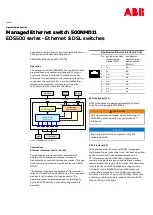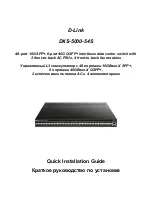
Aggregated Links
27
Aggregated Links and
Your Switch
When any port is assigned to an aggregated link (either manually or via
LACP) it will adopt the configuration settings of the aggregated link.
When a port leaves an aggregated link its original configuration settings
are restored.
A maximum of four active aggregated links can be created. A maximum
of four ports may be added manually to any individual aggregation, but
any number may join automatically via LACP. There are however a few
points to consider:
■
When creating an aggregation between two systems, the ports in the
aggregation must not be physically connected together until the
aggregation has been correctly configured at both ends of the link.
Failure to configure the aggregation at both ends before physically
connecting the ports can result in a number of serious network issues
such as lost packets and network loops.
■
If multiple links are connected between a unit and more than four
other devices, only four of the devices will be assigned to aggregated
links. The remaining devices will each only have one link made active,
that is, passing data. All other links will be made inactive to prevent
loops occurring.
LACP detects if one of the existing four aggregated links is removed
and will then automatically assign one of the remaining devices to the
aggregated link that has become free.
■
When multiple links of different speed connect two devices only the
highest speed links will be aggregated. The other links will be held in a
standby state until there is a problem with a higher speed link(s). The
lower speed link(s) will then become active.
■
Note that the port security must be disabled on any port that is to
become part of an aggregated link. It is not possible to configure this
feature on a port that is a member of an aggregated link, and vice
versa.
■
A LinkUp / LinkDown trap will only be sent for individual links. The
Traps will not be sent for an aggregation.
■
Switch 4900 Series and Switches 4050/4060 — When two Switches
are interconnected to create a Distributed Fabric, each Switch can
provide intelligent local forwarding. This means that Layer 2 traffic
originating from the edge of the network and destined for a device
directly connected to one of the Switches in the Distributed Fabric, is
Summary of Contents for SuperStack 3C17300
Page 12: ...14 ...
Page 30: ...32 CHAPTER 2 OPTIMIZING BANDWIDTH ...
Page 36: ...38 CHAPTER 3 USING MULTICAST FILTERING ...
Page 45: ...How STP Works 47 Figure 11 STP configurations ...
Page 76: ...78 ...
Page 80: ...82 APPENDIX A CONFIGURATION RULES ...
Page 86: ...88 APPENDIX B NETWORK CONFIGURATION EXAMPLES ...
Page 102: ...104 GLOSSARY ...
















































